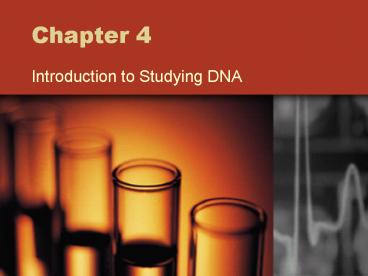Introduction to Studying DNA PowerPoint PPT Presentation
Title: Introduction to Studying DNA
1
Chapter 4
- Introduction to Studying DNA
2
(No Transcript)
3
Sources of DNA-Prokaryotic DNA
- Nearly all prokaryotes have a single circular
chromosome - Contained within a conglomeration of ribosomes
- Other proteins related to transcription and
translation - Region called the nucleoid
- Opposed to the well defined, double membrane
bound eukaryotic nucleus - Certain exceptions
- Borrelia burgdorferi and the genus Streptomyces
contain linear chromosomes, like the eukaryotes - Vibrio cholerae, the causative agent of cholera
- Has two circular chromosomes
- Smaller of which contains most of the genes
responsible for virulence
4
Sources of DNA-Prokaryotic DNA
- Plasmids
- Small (about 1 to 10 thousand base pairs),
circular pieces of DNA - Replicated by the host's DNA replication
machinery - Genes are not absolutely critical for general
survival - In nature
- Usually contain special genes that confer some
type of selective advantage such as antibiotic
resistance - Called the R plasmids
- Virulence
- In genetic engineering artificially introduced
plasmids carry genes to be expressed and studied - They are Transformed-take up foreign DNA and
express the genes on the newly acquired DNA
5
(No Transcript)
6
Sources of DNA-Bacterial Cell Culture
- Bacterial cells must be provided with an
environment to grow - Broth
- Liquid medium
- Agar
- Solid medium
7
Sources of DNA-Bacterial Cell Culture
- Agar
- Unbranched polysaccharide
- Obtained from the cell walls of some species of
red algae or seaweed - polymer made up of subunits of the sugar
galactose - Agar polysaccharides serve as the primary
structural support for the algae's cell walls
8
(No Transcript)
9
Sources of DNA-Mammalian Cell Culture
PowerShow.com is a leading presentation sharing website. It has millions of presentations already uploaded and available with 1,000s more being uploaded by its users every day. Whatever your area of interest, here you’ll be able to find and view presentations you’ll love and possibly download. And, best of all, it is completely free and easy to use.
You might even have a presentation you’d like to share with others. If so, just upload it to PowerShow.com. We’ll convert it to an HTML5 slideshow that includes all the media types you’ve already added: audio, video, music, pictures, animations and transition effects. Then you can share it with your target audience as well as PowerShow.com’s millions of monthly visitors. And, again, it’s all free.
About the Developers
PowerShow.com is brought to you by CrystalGraphics, the award-winning developer and market-leading publisher of rich-media enhancement products for presentations. Our product offerings include millions of PowerPoint templates, diagrams, animated 3D characters and more.

